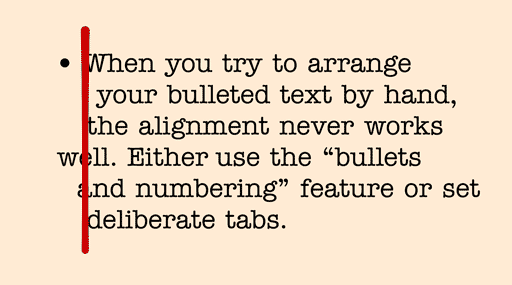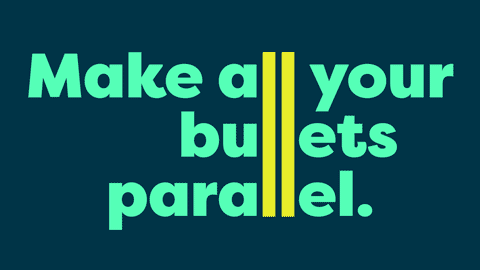How to Bullet Better
A guide to writing impeccable and effective lists

A vertical list is a dandy way to help your reader scan and absorb information. But many lists suffer from problems that compromise their clarity. To ensure that all your lists are impeccable and effective, keep reading.
Numbers? Or no?
If your list is sequential (as in a soufflé recipe or CPR instructions), or if you want to clearly differentiate each of the items (as in the Ten Commandments or a prenuptial agreement), you’ll want to number it. But if numbers aren’t needed, you can opt for bullets instead.
Bullets? But I’m a pacifist!
Don’t worry—these punctuation marks aren’t dangerous. They just happen to share their etymology with gun projectiles. The word bullet comes from the diminutive of the French word boule, meaning ball: boulette. So think of the bullets in your lists as cute little spheres, not deadly lead slugs.
Go for a good look.
As for formatting, computer programs usually automate bullet best practices:
- All the bullets sit in a vertical line.
- Each bullet is situated to the left of the first letter of the text it’s highlighting, padded by a bit of space.
- All the bulleted text is left-aligned.
- Both the bullets and their corresponding text are indented.
Having proofread a few billion documents in my day, I’ll tell you this: When designers attempt to hand-align bulleted text, they never succeed.

Resist jazzing up your bullets.
Clean little bullets are likely your best design choice. Bryan Garner, in his Modern English Usage (Fifth Edition), suggests that you “resist the temptation to play with hollow characters, smiley faces, check marks, and the like.” He advises, “[U]nless you’re trying for an offbeat appearance, use real bullet dots.”
Start with your style guide.
Some organizations follow Associated Press style; others adhere to The Chicago Manual of Style. You might have a house style guide you’re supposed to follow. If your bulleting approach is spelled out for you, then you know what you need to do. If you’re flying guideless, then you can make some choices.
You might be wondering.
With no style guide to follow, you might have questions:
- Do my bullets need to be complete sentences?
- What punctuation should I use?
- Must I capitalize the first letter of each bullet?
In general, you should do whatever is cleanest and easiest to read and whatever jibes best with your design.
In the three preceding bullets, I opted to use complete sentences. So it made sense to begin them with a capital letter and end them with terminating punctuation. But if I want to make a simple list of, say, annoyances, I might forgo both punctuation and capitalization, like this:
- hiccups
- hangnails
- houseflies
Consistency is key.
Within a set of bullets, make sure you take a consistent approach to capitalization and punctuation. Similarly, if you highlight, bold, and/or underline the first sentence, word, or phrase in one bullet, do the same with all of them, as I’ve done in the example below.
Here are a few of the contraband items people have tried to sneak past the TSA (Transportation Security Administration):
- Animals. One woman was stopped with 109 live creatures that included white porcupines, armadillos, turtles, chameleons, and—you guessed it—snakes.
- Drugs. A crutch, a bottle of body wash, and a box of Whoppers are just some of the places people have attempted concealment.
- Weapons. Guns have been found inside a teapot, a box of Legos, and (points for creativity!) a raw chicken.
The write stuff: Practice parallelism.

Parallel writing makes your bullets easier to understand (and often, nicer sounding). When bullets are parallel, they all take the same structural approach. I’ll give you some examples.
Her hobbies include:
- Playing shuffleboard
- Conducting séances
- Domesticating raccoons
These three bullets are parallel because they each begin with a gerund (a noun made from the -ing form of a verb.) I’d also classify these bullets as extra parallel because they also each include a single-word object (shuffleboard, séances, and raccoons). Other phrases in this series might be “knitting kneepads,” “stealing scooters,” and “training fleas.”
Here’s another approach. If you wanted to proclaim your promises to your spouse, you could write something like the following.
I swear I will always:
- eliminate any house varmints
- leave the toilet seat down
- admit when I’m wrong
Each of these bullets begins with a verb and can smoothly finish the sentence that begins with I swear I will always. They’re all parallel.
Go forth and bullet.
The goal of any written piece is to be noticed, read, and understood by its reader. And bullets often help achieve that goal. So as you write, design, and/or proofread your bullets, make sure that they’re all easy on the eyes and friendly to the brain.
This article was last modified on July 2, 2025
This article was first published on July 2, 2025



